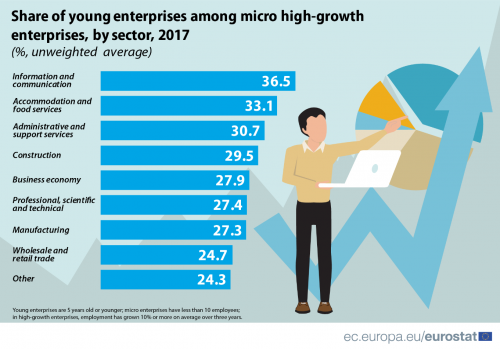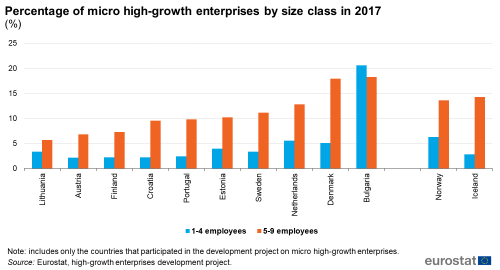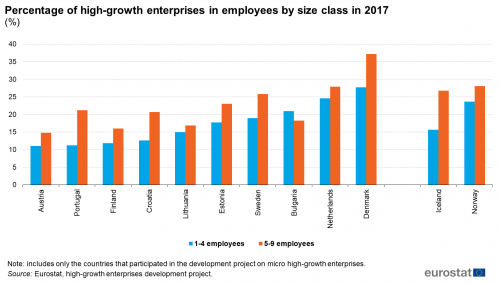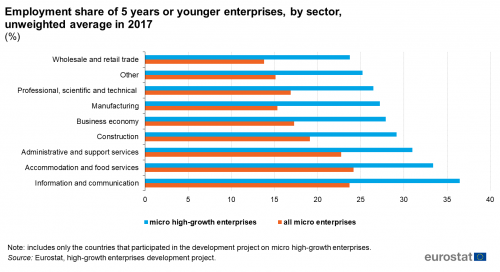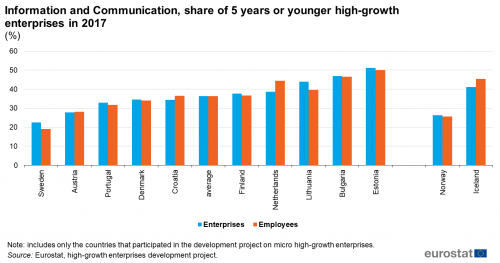Characteristics of micro high-growth enterprises
Data extracted in December 2020
No update planned for this article.
Highlights
Approximately 25-30 % of micro high-growth enterprises are young enterprises up to 5 years old.
In the information and communication sector, on average 37 % of micro high-growth enterprises were young enterprises up to 5 years old.
Economic growth and job creation have been key issues on the European political agenda for years. At enterprise level, high-growth enterprises (HGEs) have a prominent and proven role in employment creation and economic growth in European countries. The regular collection of data on HGEs currently covers enterprises recording average annualised employment growth of 10 % or more over a three-year period. In addition, the enterprises have at least 10 employees when they start growing. For many years now, high-growth enterprises have been an established and regulated part of the Business Demography data collection. The methodology for assessing micro high-growth enterprises was developed and tested as part of the pilot action. The approach adopted is largely in line with the methodology currently used for identifying and measuring HGEs with 10 or more employees.
This article is based on the experimental statistical results of a recent pilot action assessing the characteristics of micro high-growth enterprises, including their size, age, legal form and group status. A total of 10 EU Member States (Bulgaria, Denmark, Estonia, Lithuania, Croatia, the Netherlands, Austria, Portugal, Finland and Sweden) and 2 EFTA countries (Iceland and Norway) participated in the development project on micro high-growth enterprises. It is the first time this kind of data on micro high-growth enterprises has been collected as part of an EU project. Due to the pilot nature of this project and the limited number and size of participating countries, the results should be interpreted with caution.
Full article
Size class
Micro high-growth enterprises are defined as enterprises employing less than 10 employees when starting their high growth period. This group of micro enterprises is not included in the statistics for traditional high-growth enterprises; these statistics only include enterprises with 10 or more employees at the beginning of the growth period. In the following analysis, micro enterprises are broken down into two size classes: 1-4 employees and 5-9 employees.
Typically, there are more micro HGEs in the size class of 5-9 employees than in the size class of 1-4 employee. The frequency of being an HGE in both size classes was the highest in Bulgaria, Denmark, Norway and the Netherlands, where around 15 % of enterprises with 5-9 employees were classified as high growth. In the smaller size class of 1-4 employees, typically 5 % or less of the enterprises were high-growth enterprises, except for Bulgaria, where more than 20 % of enterprises with 1-4 employees were classified as HGEs. It should be noted that the criterion for being classified as an HGE was to have a minimum increase of 3.3 employees in the enterprise over a period of three years, which is obviously more easy to obtain in larger enterprises (5-9 employees) than in smaller ones (1-4 employees) (see methodological note as well).
When looking at the employee shares of micro HGEs, the difference between size classes of 1-4 employees and 5-9 employees is not substantial (see Figure 2). High-growth enterprises account for a larger share of employees in the 5-9 size class, typically around 15-25 %. In the smaller size class of 1-4 employees, the contribution of HGEs to employment is considerable, though somewhat smaller than in the 5-9 employee size class.
The highest employee shares - well above 20 % in both size classes - were recorded for Denmark, the Netherlands and Norway. By contrast, the lowest HGE employee shares of 1-4 employee size class were observed in Austria, Portugal, Finland and Croatia, accounting for around 11-13 % of employees in this size class. The lowest HGE employee shares in the 5-9 employee size class were in Austria, Finland and Lithuania, at roughly 15 %.
Legal form
Business demography statistics include the legal form of the enterprise as one of the variables. When dealing with high-growth enterprises, it is often the case that the potential for high growth is best realised in the legal form of a limited liability company. Such a company generally has better access to finance, risk capital and skilled employees – all critical conditions for high growth - as compared to other legal forms of sole proprietorships or partnerships.
The limited liability company is a dominant legal form in micro enterprises with 1-10 employees across the participating countries (see Figure 3). On average, almost 70 % of these enterprises were limited liability companies, while they were even more frequent among micro HGEs, accounting for more than 80 % of these enterprises.
The pattern appears to be relatively stable across participating countries. In five countries (Estonia, Portugal, Sweden, Lithuania and Iceland), more than 90 % of micro HGEs were limited liability companies, whereas the lowest shares were observed in Austria, Denmark and the Netherlands, around 60 %. In all countries, the limited liability companies were more frequent in micro HGEs compared to all micro enterprises. In conclusion, the average frequency of limited liability companies among HGEs is higher than that for all micro enterprises. This implies that the potential for high growth in relation to the legal form structure seems favourable in micro HGEs, given the favourable conditions that limited liability companies have for accessing critical resources such as finance, risk capital and skills.
Group status
Group status reflects the independence of the enterprise, i.e. whether an enterprise belongs to an enterprise group or not. If an enterprise belongs to an enterprise group, it may have less decision-making power than genuinely independent enterprises. On the other hand, enterprises within the group may have better access to multiple resources, such as skilled employees, research and innovation, marketing, technology and finance. Therefore, in the context of high-growth enterprises it is important to understand the role of group structure as a facilitator for growth.
In earlier Eurostat pilot projects, group status has been included and analysed with some quite interesting results[1]. Considerable differences in the share of dependent vs. independent enterprises are also typical across countries. Figure 4 shows that there are four countries – Austria, Sweden, Norway and Iceland - where around 40 % of all HGEs are dependent micro HGEs, which is a prominent proportion. At the other end, less than 10 % of enterprises were dependent enterprises in Bulgaria, the Netherlands, Portugal, Croatia and Finland, implying that a great majority of the micro HGEs in these countries - more than 90 % - have an independent status.
However, when measuring the volume of employees or value added, dependent enterprises have a more pronounced role in this. Dependent micro HGEs had higher shares of employment and value added compared to their share of enterprises in all countries. Furthermore, dependent micro HGEs had higher value added shares than shares of employment in all countries, thus emphasising their economic importance. Dependent micro HGEs with the highest shares of employment and value added were recorded for Austria, Sweden, Norway and Iceland, i.e. also the same countries with the highest shares with enterprises.
Looking at the group status of micro enterprises by size class, broken down into 1-4 and 5-9 employees (see Figure 5), shows a consistent pattern in all countries, with the frequency of dependent HGEs somewhat higher in the 5-9 employee size class compared to the 1-4 employee size class. The largest differences between size classes were observed in the same countries that had the highest shares of dependent micro HGEs, i.e. Sweden, Austria, Iceland and Norway.
Age of an enterprise
The age of an enterprise is an interesting factor to follow in the context of high-growth enterprises. Traditionally young, meaning less than 5 years old, high-growth enterprises have been a population of special attention, since they form the core of the most dynamic enterprises in our economies. Even if the number of enterprises in this group is not that large, it includes enterprises with high potential for rapid growth and expansion. It is worth noting that the definition for age is not always explicit nor is it always fully comparable across countries.
The age of the enterprises was broken down into three age groups: 5 years old or less (young enterprises), 5-10 years old and more than 10 years old. Figure 6 shows the employees by different enterprise age groups in micro HGEs and all micro enterprises. It is clear that young micro HGEs and micro HGEs that are 5-10 years old have a higher share of employees than all micro enterprises, while the opposite is true for enterprises 10 or more years old. While some 45 % of the employees of micro HGEs were in enterprises 10 years or older, more than 60 % of the employees of all micro enterprises belonged to this age class.
Figure 7 shows the share of young micro HGEs out of all HGEs and the share of young enterprises out of all micro enterprises, broken down by NACE section. In all sectors, the share of young high-growth enterprises is much higher than that of micro enterprises on average, suggesting that the micro HGEs tend also to be young enterprises. This interesting result may also have some obvious policy implications when roughly 25-30 % of micro HGEs are maximum 5 years old while a much smaller share - some 15-20 % - of all micro enterprises qualify as falling into the age group of young enterprises.
Obviously, in certain sectors - such as information and communication, accommodation and food services – the density of young high-growth enterprises is higher than in other sectors of the economy. For example in information and communication, on average almost 37 % of micro high-growth enterprises were maximum 5 years old, while about 27 % of all micro high-growth enterprises in the business economy were 5 years old or younger.
Looking at the employment shares of young micro HGEs and all micro enterprises by sector, the outcome appears much the same. It is clear that the employment share of young HGEs is also roughly 10 percentage points higher than the employment share of all micro enterprises in each sector. The youngest profile of enterprises is in information and communication, accommodation and food services and administrative services; in all these activities young enterprises accounted for 30 % or more of both enterprises and employees. The enterprises least young were recorded in the traditional sectors of trade, other services and professional and technical services, which were largely business services.
Figure 9 shows the share of young micro HGEs out of all micro HGEs across countries in the business economy. It should be noted that the country comparison is made with reservations, since measuring or identifying the age of an enterprise is not a straightforward task and country practices may differ. As a result, Sweden, Austria, Norway and Denmark appear to have the lowest share of young enterprises in the business economy, roughly 20 %. This applies to both the share of enterprises and their employees.
By contrast, the largest share of young HGEs appears to be in Bulgaria, Estonia, Lithuania and the Netherlands. In these countries some 35-40 % of micro HGEs were young, which is almost double the frequency compared to the lowest ranking countries. In the business economy, the shares of micro HGEs and their employees closely follow each other.
The role of young high-growth enterprises in the information and communication sector in different countries is shown in Figure 10. It appears that the age structure of enterprises in this sector varies a lot across countries. The highest share of young enterprises was observed in Estonia and Bulgaria followed by Lithuania and Iceland where more than 40 % of the micro HGEs in information and communication were 5 years old or younger. At the other end, in Sweden and Norway slightly over 20 % of HGEs were young while the average of the countries was 37 %. Figure 10 also shows that the share of young HGEs and the share of employees in these enterprises follow each other very closely in the information and communication sector.
Type of growth
The definition of high growth traditionally includes only organic growth, meaning it excludes growth due to mergers, acquisitions and takeovers. In this pilot project, the focus was also to assess the role of organic vs. gross growth, including also growth due to mergers, acquisitions and takeovers. As the countries have different tools and practices for tracing organic vs. gross growth, the results should be interpreted with caution. In addition, the data was available only for a limited number of countries.
Looking at Figure 11, two groups of countries clearly stand out. In the majority of countries, organic growth applies to some 90 % or more of all micro HGEs observed. For these countries, the same levels apply also for employees and value added. The data for Sweden, Finland and partly the Netherlands suggest that if taken into account, mergers, acquisitions and takeovers would considerably increase the number of high-growth enterprises, their employees and value added. In these countries, roughly two thirds of growth can be considered organic while one third is due to mergers, takeovers or acquisitions. In other countries where the data is available, close to 100 % is due to organic growth. The results may be explained by the fact that there are different tools and capabilities in countries to trace growth that is not organic.
Conclusions
The proportion of micro HGEs is higher in the size class of 5-9 employees compared to the size class of 1-4 employees. The HGE frequencies in both size classes were the highest in Bulgaria, Denmark, Norway and the Netherlands, where around 15 % of enterprises with 5-9 employees were classified as high growth.
Group status reflects the independence of the enterprise i.e. whether the enterprise belongs to an enterprise group or not. If an enterprise belongs to an enterprise group, it may have less decision-making power than genuinely independent enterprises. On the other hand, enterprises within the group may have better access to multiple resources, such as skilled employees, research and innovation, marketing, technology and finance. Therefore, in the context of high-growth enterprises it is important to understand the role of group structure as a facilitator for growth. There are four countries – Austria, Sweden, Norway and Iceland - where dependent micro HGEs account for a prominent share of all HGEs at around 40 %. At the other end, dependent enterprises accounted for less than 10 % of enterprises in Bulgaria, the Netherlands, Portugal, Croatia and Finland. This implies that a great majority, more than 90 %, of the micro HGEs in these countries have independent status. When measuring the volume of employees or value added, dependent enterprises have a more pronounced role in this.
Traditionally young, i.e. less than 5 years old, high-growth enterprises have been a population of special attention since they comprise the core of the most dynamic enterprises in our economies. Even if this group is not that large in terms of the number of enterprises, it includes enterprises with a high potential for rapid growth and expansion. In all sectors, the share of young high-growth enterprises is much higher than the share of micro enterprises on average, suggesting that the micro HGEs tend also to be young enterprises. Approximately 25-30 % of micro HGEs are maximum 5 years old, while a much smaller share - some 15-20 % - of all micro enterprises qualify as falling into the age group of young enterprises.
Looking at the employment shares of young micro HGEs and all micro enterprises by sector, the outcome appears much the same. It is clear that the employment share of young HGEs is also roughly 10 percentage points higher than the employment share of all micro enterprises in each sector. The youngest profile of enterprises is in information and communication, accommodation and food services and administrative services; in all these activities, young enterprises accounted for 30 % or more of both enterprises and employees. The enterprises least young were recorded in the traditional sectors of trade, other services and professional and technical services, which were largely business services.
Feedback
To help Eurostat improve these experimental statistics, users and researchers are kindly invited to give us their feedback by email
Source data for tables and graphs
Data sources
The methodology applied for defining micro high-growth enterprises
The methodology applied requires that the minimum growth in absolute numbers for a micro HGE is 3.31 employees in 3 years. This threshold is drawn from current HGE methodology where an enterprise with exactly 10 employees in the beginning of growth, having average annualised growth of 10% in the number of employees over a three-year period, would have the number of employees in year t at least 1.331 times higher than in year t-3. For reasons of consistency, the scope of the micro enterprises is limited only to the size class of 1-9 employees in the year of the beginning of growth and consequently omits the 0-employee size class.
In this project, the same absolute number of growth (3.31 employees) is applied to enterprises with 1 to 9 employees at the starting year of the growth (t-3). As a result, the population of micro high-growth enterprises needs to grow by at least 3.31 employees in 3 years. The methodology applied should, in principle, follow the same as in the OECD-Eurostat manual on BD, and in particular the relevant parts dealing with high-growth enterprises. This harmonised methodology would make it possible to compare and benchmark the standard HGE data with our new micro HGE data.
It is also important to emphasize the issue of head count versus full-time equivalent (FTE), as country practices may differ. Also, the number and share of part time workers may influence the figures across sectors and countries.
Context
Economic growth and job creation have been key issues on the European political agenda for many years. At enterprise level, high-growth enterprises (HGEs) have a prominent and proven role in employment creation and economic growth in European countries. The current definition for high-growth enterprises excludes all enterprises having 1 to 9 employees in the beginning of the growth period (i.e. 3 years before the reference year); therefore these enterprises do not belong to the current business demography data collection on HGEs.
The results are based on the experimental statistical results of a recent pilot action assessing the role of micro high-growth enterprises in economic growth and job creation. A total of 10 EU Member States (Bulgaria, Denmark, Estonia, Lithuania, Croatia, the Netherlands, Austria, Portugal, Finland and Sweden) and 2 EFTA countries (Iceland and Norway) participated in the development project on micro high-growth enterprises. It is the first time this kind of data on micro high-growth enterprises has been collected as part of an EU project. Due to the pilot nature of this project and the limited number and size of participating countries, the results should be interpreted with caution.
Direct access to
See also
Dedicated section
